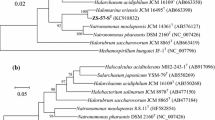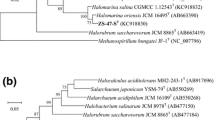Abstract
A halophilic archaeal strain, SKJ47T, was isolated from a commercial preparation of the brown alga Laminaria produced at Dalian, Liaoning Province, China. Cells of the strain were observed to be short rods, stain Gram-negative, and to form red-pigmented colonies on solid media. Strain SKJ47T was found to be able to grow at 20–50 °C (optimum 37 °C), at 0.9–4.8 M NaCl (optimum 2.6–3.1 M), at pH 6.0–9.5 (optimum pH 7.0). The cells lysed in distilled water and the minimal NaCl concentration to prevent cell-lysis was found to be 5 % (w/v). The major polar lipids of the strain were identified as phosphatidylglycerol, phosphatidylglycerol phosphate methyl ester, phosphatidylglycerol sulfate and two glycolipids chromatographically identical to those of Halopenitus persicus IBRC 10041T. The 16S rRNA gene and rpoB′ gene of strain SKJ47T were found to be phylogenetically related to the corresponding genes of Halopenitus malekzadehii IBRC-M 10418T (96.3 and 91.9 % nucleotide identity, respectively) and Hpt. persicus IBRC 10041T (96.2 and 93.8 %). The DNA G+C content of strain SKJ47T was determined to be 65.0 mol%. The phenotypic, chemotaxonomic and phylogenetic properties suggested that strain SKJ47T (=CGMCC 1.12229T = JCM 18641T) represents a new species of the genus Halopenitus, for which the name Halopenitus salinus sp. nov. is proposed.

Similar content being viewed by others
References
Amoozegar MA, Makhdoumi-Kakhki A, Shahzadeh Fazeli SA, Azarbaijani R, Ventosa A (2012) Halopenitus persicus gen. nov., sp. nov., an archaeon from an inland salt lake. Int J Syst Evol Microbiol 62:1932–1936
Amoozegar MA, Makhdoumi-Kakhki A, Mehrshad M, Shahzadeh Fazeli SA, Ventosa A (2013) Halopenitus malekzadehii sp. nov., a novel extremely halophilic archaeon from a salt lake. Int J Syst Evol Microbiol 63:3232–3236
Burns DG, Janssen PH, Itoh T, Kamekura M, Echigo A, Dyall-Smith ML (2010) Halonotius pteroides gen. nov., sp. nov., an extremely halophilic archaeon recovered from a saltern crystallizer. Int J Syst Evol Microbiol 60:1196–1199
Collins MD (1985) Isoprenoid quinone analysis in bacterial classification and identification. In: Goodfellow M, Minnikin DE (eds) Chemical methods in bacterial systematics. Academic Press, London, pp 267–287
Cui H-L, Lin Z-Y, Dong Y, Zhou P-J, Liu S-J (2007) Halorubrum litoreum sp. nov., an extremely halophilic archaeon from a solar saltern. Int J Syst Evol Microbiol 57:2204–2206
Cui H-L, Zhou P-J, Oren A, Liu S-J (2009) Intraspecific polymorphism of 16S rRNA genes in two halophilic archaeal genera, Haloarcula and Halomicrobium. Extremophiles 13:31–37
Cui H-L, Gao X, Yang X, Xu X-W (2010) Halorussus rarus gen. nov., sp. nov., a new member of the family Halobacteriaceae isolated from a marine solar saltern. Extremophiles 14:493–499
Cui H-L, Yang X, Mou Y-Z (2011) Salinarchaeum laminariae gen. nov., sp. nov.: a new member of the family Halobacteriaceae isolated from salted brown alga Laminaria. Extremophiles 15:625–631
Cui H-L, Qiu X–X (2014) Salinarubrum litoreum gen. nov., sp. nov.: a new member of the family Halobacteriaceae isolated from Chinese marine solar salterns. Antonie Van Leeuwenhoek 105:135–141
Dussault HP (1955) An improved technique for staining red halophilic bacteria. J Bacteriol 70:484–485
Gonzalez C, Gutierrez C, Ramirez C (1978) Halobacterium vallismortis sp. nov. an amylolytic and carbohydrate-metabolizing, extremely halophilic bacterium. Can J Microbiol 24:710–715
Gutiérrez C, González C (1972) Method for simultaneous detection of proteinase and esterase activities in extremely halophilic bacteria. Appl Microbiol 24:516–517
Marmur J, Doty P (1962) Determination of the base composition of deoxyribonucleic acid from its thermal denaturation temperature. J Mol Biol 5:109–118
McDade JJ, Weaver RH (1959) Rapid methods for the detection of gelatin hydrolysis. J Bacteriol 77:60–64
Meier-Kolthoff JP, Göker M, Spröer C, Klenk H-P (2013) When should a DDH experiment be mandatory in microbial taxonomy? Arch Microbiol 195:413–418
Minegishi H, Kamekura M, Itoh T, Echigo A, Usami R, Hashimoto T (2010) Further refinement of Halobacteriaceae phylogeny based on the full-length RNA polymerase subunit B’ (rpoB ’) gene. Int J Syst Evol Microbiol 60:2398–2408
Oh D, Porter K, Russ B, Burns D, Dyall-Smith M (2010) Diversity of Haloquadratum and other haloarchaea in three, geographically distant, Australian saltern crystallizer ponds. Extremophiles 11:161–169
Oren A, Ventosa A, Grant WD (1997) Proposed minimal standards for description of new taxa in the order Halobacteriales. Int J Syst Bacteriol 47:233–238
Oren A, Arahal DR, Ventosa A (2009) Emended descriptions of genera of the family Halobacteriaceae. Int J Syst Evol Microbiol 59:637–642
Oren A (2012) Taxonomy of the family Halobacteriaceae: a paradigm for changing concepts in prokaryote systematics. Int J Syst Evol Microbiol 62:263–271
Qiu X–X, Zhao M-L, Han D, Zhang W-J, Cui H-L (2013) Halorubrum rubrum sp. nov., an extremely halophilic archaeon from a Chinese salt lake. Antonie Van Leeuwenhoek 104:885–891
Tamura K, Peterson D, Peterson N, Stecher G, Nei M, Kumar S (2011) MEGA5: molecular evolutionary genetics analysis using maximum likelihood, evolutionary distance, and maximum parsimony methods. Mol Biol Evol 28:2731–2739
Zhang W-J, Han D, Qiu X–X, Zhao M-L, Mou Y-Z, Cui H-L, Li Z-R (2013) Halobellus rarus sp. nov., a halophilic archaeon from an inland salt lake of China. Antonie Van Leeuwenhoek 104:377–384
Zhang W-J, Cui H-L (2014) Haloarchaeobius litoreus sp. nov., isolated from a marine solar saltern. Antonie Van Leeuwenhoek 105:1085–1090
Acknowledgments
This work was supported by the National Natural Science Foundation of China (No. 31370054), the grant from China Ocean Mineral Resources R & D Association (COMRA) Special Foundation (DY125-15-R-03), the Qinglan Project of Jiangsu Province and a project funded by the Priority Academic Program Development of Jiangsu Higher Education Institutions (PAPD). We are grateful to Dr. M. A. Amoozegar for kindly providing strains Halopenitus persicus IBRC 10041T and Halopenitus malekzadehii IBRC-M 10418T.
Author information
Authors and Affiliations
Corresponding authors
Additional information
Phase-contrast micrograph of strain SKJ47T, thin-layer chromatograms of strain SKJ47T and related members are available as supplementary materials.
Electronic supplementary material
Below is the link to the electronic supplementary material.
Rights and permissions
About this article
Cite this article
Han, D., Cui, HL. & Li, ZR. Halopenitus salinus sp. nov., isolated from the brine of salted brown alga Laminaria . Antonie van Leeuwenhoek 106, 743–749 (2014). https://doi.org/10.1007/s10482-014-0244-y
Received:
Accepted:
Published:
Issue Date:
DOI: https://doi.org/10.1007/s10482-014-0244-y




